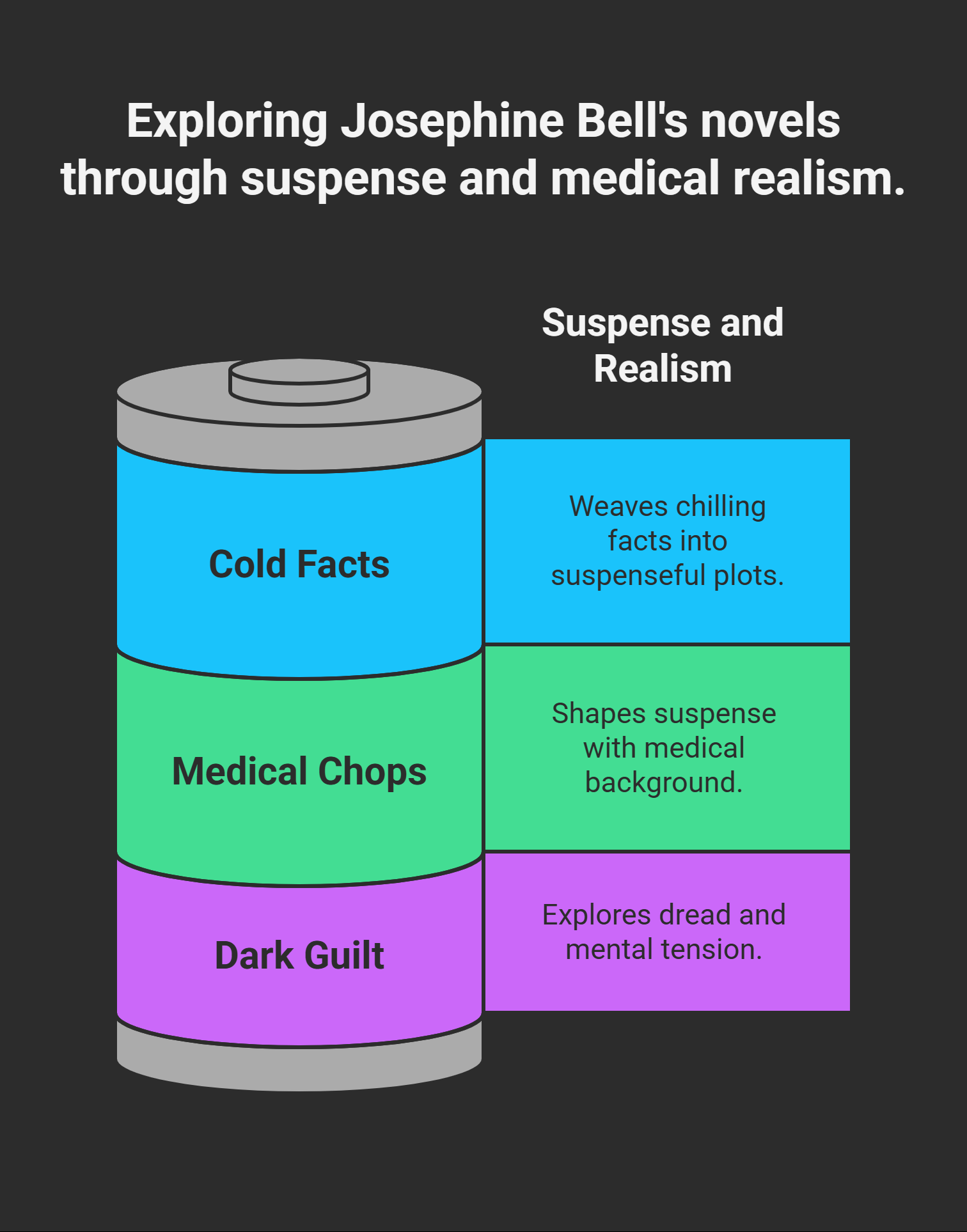Viewers often get lost in true crime stories. They wonder what parts come from real events. Josephine Bell shows up in Under the Bridge, the Hulu show based on Rebecca Godfrey’s book about the Murder of Reena Virk.
She links to a case in British Columbia that ended with a second-degree murder verdict. This post will clear up her role, explain her link to Kelly Ellard and Warren Glowatski, and show how bullying and assault led to that tragedy.
Ready to see the truth? Keep reading.
Key Takeaways
- Doris Bell Collier (born April 17 in Manchester) took the pen name Josephine Bell after studying at a women’s college in Cambridge until 1919 and earning her MRCS, LRCP, MB, BS qualifications in 1924.
- She served as a junior assistant physician at University College Hospital in London, then traded her stethoscope for a pen in 1923 to write over 30 detective novels infused with real medical detail.
- Bell’s work appears in Hulu’s Under the Bridge and Rebecca Godfrey’s book on the 1997 Reena Virk murder in British Columbia, a case that led to second-degree murder verdicts for Kelly Ellard and Warren Glowatski.
- Her novels use dark guilt, dread, fast pacing, and clue-based plotting so each wound and red herring feels real—readers “race” through scenes as if in a lab or courtroom.
- Critics in London praise her crisp medical insight, and crime-writing guilds still cite her legacy in national library archives for reshaping modern detective fiction.
The Life of Josephine Bell
Bell was born Doris Collier in Manchester and studied at a women’s school in Cambridge until 1919. Swapping her white coat for a pen name, she built a bibliography of crime tales that hark back to her days in a city lab.
Early Years and Education
Doris Bell Collier arrived in Manchester on April 17. Her boarding school days helped her love biology and tales of human drama. She stayed at a women’s college in Cambridge until 1919.
Her diplomas, MRCS, LRCP, MB, and BS, came through in 1924.
She joined a teaching hospital as a junior assistant physician. Her work in pathology turned into fodder for crime scenes. She chose Josephine Bell’s name as the pseudonym of Doris Bell Collier.
That choice let her balance scalpel and pen, stethoscope and suspense.
Transition from Medicine to Writing
Bell studied medicine at Newnham College, then served at University College Hospital in London. She earned her M.B., B.S., MRCS and L.R.C.P. At each ward she wrote case notes at Luke’s Hospital and a research hospital in London.
Doctors praised her clear mind and firm hand.
She traded a stethoscope for a pen in 1923. A move to Guildford led her to write detective novels. Bell tapped her medical background to shape crime scenes. She kept her birth name private.
A Vice article called her a blonde, delicate girl keen on gangster rap, the Mafia, and John Gotti.
Unraveling the Enigma of Josephine Bell’s Works
Bell drops clues like breadcrumbs, mixing her practice with a knack for suspense that makes pages fly. She uses a tool called pacing, turning a simple chase into a pulse-racing ride.
Themes and Unique Style in Her Novels
Dark guilt and dread seep through each scene. Mental tension strikes like lightning in the night. A cigarette burn on Reena’s forehead jumps off the page. Shock builds when six girls and one boy, Warren Glowatski, gang up on an innocent.
Churned emotions swirl in group homes and Luke’s Hospital wards. A mother shivers when she catches Kelly Ellard plotting to bury a girl alive. Clue-based plotting sharpens every hint, like a worn scalpel.
Medical chops from Newnham College and a research hospital shape every cut of suspense.
Influence of Her Medical Background on Her Stories
She trained at Newnham College, then earned her M.R.C.S. She served as a junior assistant at Luke’s Hospital in London, and she worked at a research hospital. She watched surgeons stitch deep cuts and log cases of abdominal trauma.
She applied that skill to Josephine Bell’s crime scenes, so each wound feels real, like a stethoscope pressed to your chest.
Scenes mirror the tragic death of Reena Virk in Canada. Ellard and Glowatski stayed; they beat her until she fell. She suffered blows to her abdomen, facial bruising, and a sneaker print bruised her brain.
Bell wove those cold facts into her plots. Readers feel the chill of prison halls and the tension of a parole trial.
Legacy and Impact
Her sharp plots reshaped crime fiction and set new rules in literary theory. A writers’ guild still cites her work, and her manuscripts fill national library archives.
Contributions to Crime Fiction
She changed crime fiction with vivid medical twists. Details from Luke’s hospital, where she worked as a junior assistant, pop up in her mysteries. A story map filled with red herrings guides every chapter, and readers chase clues like they hold a lens.
Her 60-day jail sentence on weekends gave her scenes raw grit. Bell maintained that blending real cases and fiction sparked new excitement.
Her use of life imprisonment themes hit home with fans. She insisted she held no hand in Reena Virk’s death, despite being found guilty of second-degree murder, and she stressed that point in letters.
She grabbed attention with laboratory checks and simple clues at the core of Josephine Bell’s style. Each page feels like a fresh hunt. She gave new writers a road map for tight, twisty plots.
Recognition in Literary Circles
Critics in London praise Bell’s crisp plots and her medical insight. They note her link to the Virk’s murder case. It sparked talks on bullying dangers and bad choices, grabbing eyeballs at literary salons.
Book clubs at Greenwich and Surrey host lively chats on her themes.
Her tie to the case hit her time at Godolphin School, hurt job hunts, and strained new friendships. Editors at crime fiction journals use her tale of Reena Virk to spark peer review sessions.
That raw edge helped her snag nods from top writers in some circles.
Takeaways
The mystery around Josephine Bell keeps you hooked. The miniseries paints her in stark color. Godfrey’s novel sketches each motive. You see how fear and loyalty collide. This drama stays in your mind like a stubborn echo.
FAQs on Josephine Bell
1. Who was Josephine Bell?
She was born Doris Bell Collier, Bell was born Doris Bell. Some call her Josephine Bell, and her pen name hints at a secret double life.
2. How does the story of Reena Virk link to Josephine Bell’s mystery?
Her tale echoes Reena Virk’s story; both show teens in danger. Their stories ask big questions, and they both shine a light on hidden wounds.
3. Where did Bell study and live?
She studied at Godolphin School. Bell began her journey with books fast. She moved to Guildford, then to Greenwich, and then to London. Later, she was living in a group home. Life felt like a tightrope walk.
4. What work did she do at Luke’s Hospital?
She worked at a research hospital, at Luke’s Hospital, in London as a junior assistant. She handled test slides, met doctors, and learned fast. The halls whispered secrets late at night.
5. Was Josephine Bell ever convicted of second-degree murder?
Yes, she was convicted of second-degree murder; the court said she crossed a deadly line. Her private life never looked the same.






































